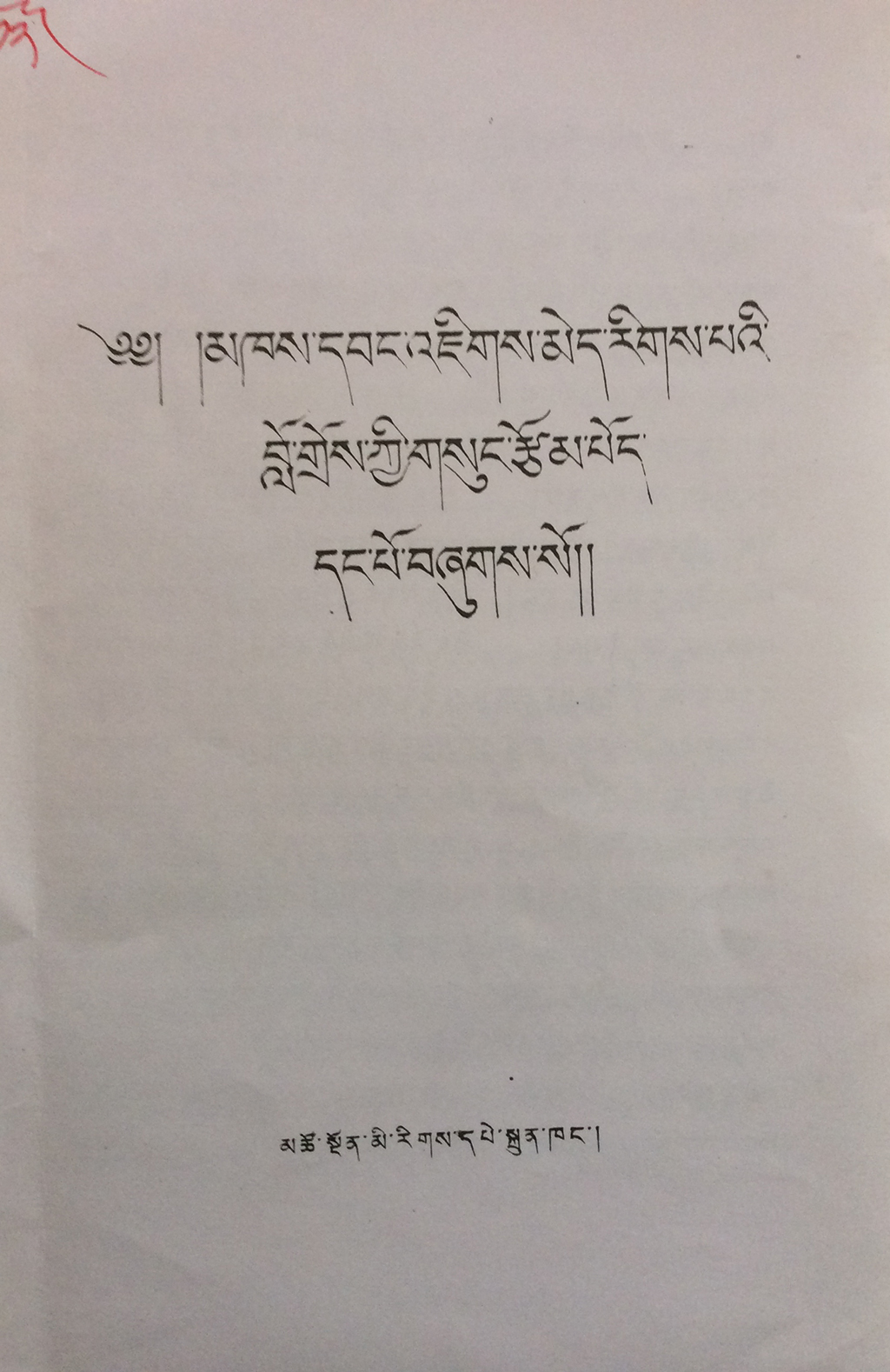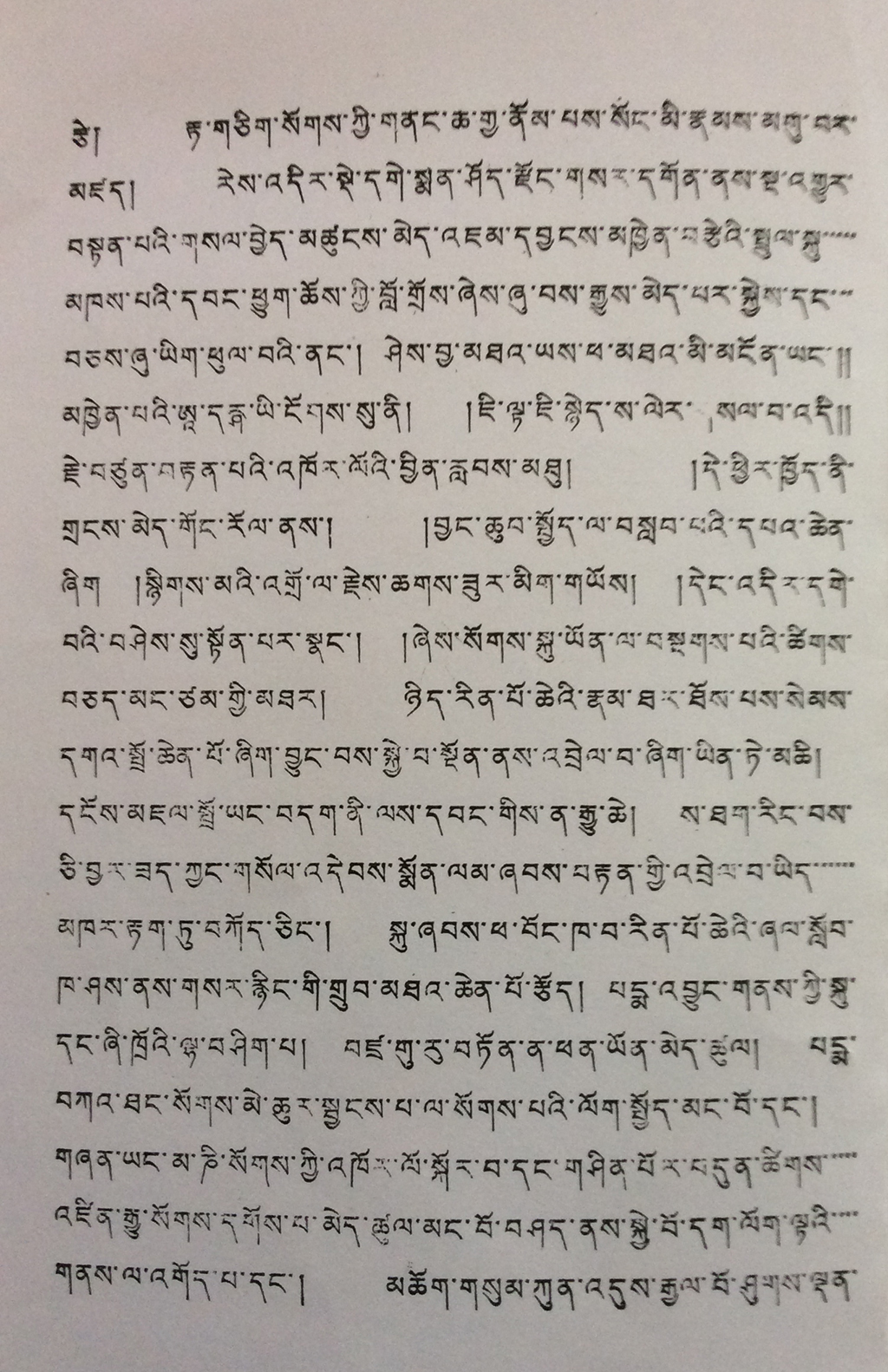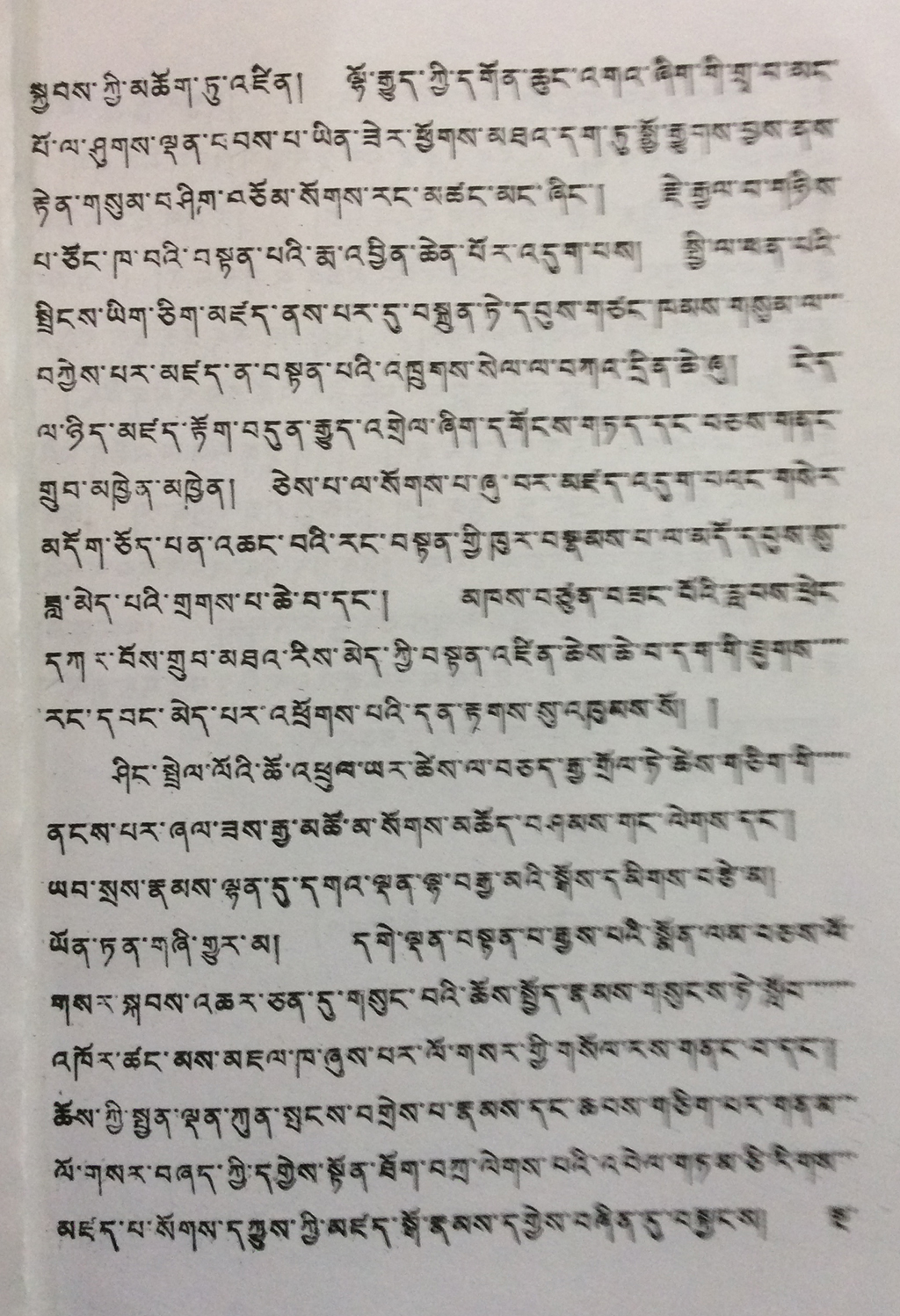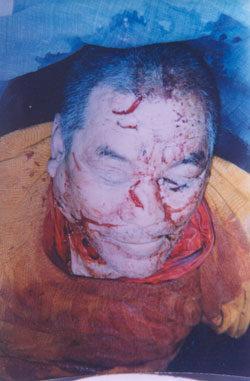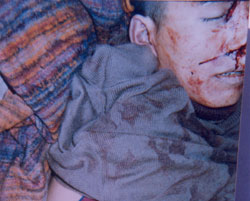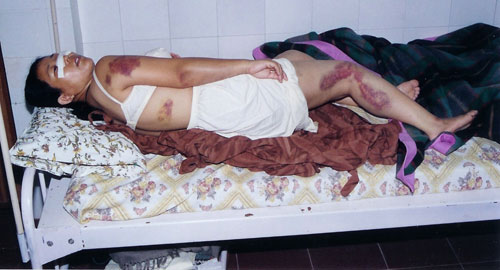[On 8th May, 1996, His Holiness gave a lengthy talk on Dolgyal at Dharamsala. The following is an excerpt from that]
When Zemey Rinpoche’s yellow back was published, it instilled fear in the minds of Geluk practitioners, restraining many nuns in Dharamsala from participating in a ceremony of an extensive feast-offering ritual to Guru Padmasambhava. When I heard about it, I felt very bad. That feast-offering to Guru Rinpoche was not for my personal gain. It was for the general wellbeing of all Tibetans. Whatever speculations or rumours people might come up with, the truth is that with regards to Shantarakshita, Guru Padmasambhava and King Trisong Detsen’s combined efforts for the establishment of Buddhism in Tibet, a special connection exists between Tibet and Guru Padmasambhava. For the shared karma of the Tibetans, we have to accumulate merit together. My own personal practice and accumulation of merit will not suffice; we have to accumulate karma together. Therefore, we give much importance to this kind of extensive feast-offerings. Anything that prevents Tibetans from participating in this is not something I am comfortable with.
Also, even as I always speak of the need for unity among all Tibetans from the three provinces, it is really shameful and sad if people are committing negativities with religious sentiments as the motivating factor behind. When I was in Tibet, I also felt the same. After my arrival in exile, I saw how fallacious sectarianism could be. Seeing great merit in having appreciation for all forms of the Buddha’s teachings and embracing an ecumenical practice that includes all, I have followed this exemplary tradition on my own accord. Thus, my study, contemplation and meditation include all forms of Buddhist traditions.
As far as one’s basic approach towards practice is concerned, if a particular instruction of an individual Lama is inconsistent with the general approach of the past masters, then Tsongkhapa advised us that we should never forsake the authoritative works [of the Buddha and his undisputed Indian disciples], but overlook the particular instruction. This is very clearly stated in his Graduated Paths to Enlightenment. In the same way, if instructions of an individual Lama deviate from the mainstream of Buddhism, and are inconsistent with the approaches of other eminent Geluk masters, we have to overlook and discard those inconsistent instructions. Based on words of just one or two eminent Lamas, it is difficult to discredit the assertions of many other past masters.
Although we see how vicious Dolgyal could be in Zemey Rinpoche’s yellow book, these are not all about his viciousness. We have numerous examples of individual Lamas, monks, families and monasteries who all met with tragedies after they started propitiating Dolgyal overtly. We have such stories from different parts of Tibet, and particularly in Kham and U-Tsang. Such stories are not mythological ones; we have people still alive who went through such experiences in the past. You should not look at this issue from only one angle, but try to see it from different perspectives, and look into the works of past eminent masters. Don’t behave in the way a blind yak would when grazing in the meadow. If you look with openness, you will come to see my points. The Buddha spoke thus:
“Oh bhikshus and scholars:
Just as gold is burnt, slashed, and ground,
Investigate my teachings thoroughly.
These instructions are given to practise,
And not to develop respect for me.”
So, by following Buddha’s own guideline, you should do the same with my words and investigate them in order to unravel the truth. There is no need to heed my advice simply because it is the Dalai Lama who spoke it. If you have genuine reason to contradict my points, it is a different matter.
If indeed Dolgyal is a protector of Tsongkhapa’s tradition, then when Tulku Dakpa Gyaltsen took a wrathful form, although he went to Tashi Lhunpo Monastery since it was the seat of Panchen Lobsang Choeki Gyaltsen, Tulku Dakpa Gyaltsen’s principle Lama in whom he had much faith, he was not allowed inside the monastery by Vaishravana and his retinue. This is mentioned in Kyabje Trijang Rinpoche’s Commentary to the Eulogy of Dolgyal and is something commonly known to the Dolgyal practitioners. If it was true that Tulku Dakpa Gyalsten rose into a wrathful form to be a protector of Tsongkhapa’s tradition, it would have been known to Panchen Lobsang Choeki Gyaltsen as well as Vaishravana. Isn’t it strange that they didn’t know about that? Unable to enter Tashi Lhunpo, he is said to have gone to Sakya where one of the hierarchal heads of Sakya or Dagchens [Dakchen Sonam Rinchen] offered Dolgyal libation and took him in. Since then, he came to be associated with the Sakya tradition. Of the different aspects of Dolgyal, Dolgyal that rides a horse was the one propitiated by some in the Sakya. It appears that, in the past, some among Sakyas had propitiated Dolgyal quite strongly.
Once, Kalu Rinpoche [the previous one] told me a story about one of his experiences. He told me that once he went on a pilgrimage to different monasteries in the Tsang region of Western Tibet. During that pilgrimage he encountered a particular experience that occured as he was visiting a Sakya monastery. He told me he could remember it very vividly: The priest in that monastery explained about the different images they had in there as is our usual practice. However, when he took Rinpoche into the protectors’ shrine room, he prostrated three times, lit incense sticks and ushered Rinpoche in in a very respectful manner. Rinpoche told me that it was Dolgyal’s shrine room. As Dolgyal was widely known for his wrath, the priest must have taken precaution. Although Dolgyal was associated with the Sakyas in the past, many Sakya masters who emerged later were critical of Dolgyal. For example, Zongsar Khyentse Choeki Lodroe was extremely critical of Dolgyal. Initially when Dolgyal was born as a wrathful being, although he tried to enter Tashi Lhunpo Monastery, the seat of Tulku Dakpa Gyaltsen’s principal Lama Panchen Lobsang Choegyal, he was not allowed inside the monastery by its protector, Vaishravana’s group of eight protectors. If Dolgyal truly took the wrathful form to be a protector of the Geluk tradition, and if he had strong faith in his master, why wasn’t he allowed inside? We have to think on this.
[On 8th Oct, 1997, His Holiness gave a talk on Dolgyal to a large group of Tibetans during a long life ceremony they offered to His Holiness. This is an excerpt from that talk.]
As far as Dolgyal is concerned, he has remained a controversial figure within the Geluk and never unanimously received an absolute approval. Its practice has proliferated only in the last sixty years. However, you must critically look into what contribution Dolgyal could have made in those years towards the Buddha Dharma in general, and specifically to Tsongkhapa’s tradition. Since Tsongkhapa’s time, and specifically during the past sixty years, there has been no instance of any concrete contribution [heightened improvement in the preservation and proliferation of the Geluk tradition] towards his tradition from Dolgyal. On the contrary, aversion towards and condemnation of Tsongkhapa’s tradition had been on the rise, leading to antagonism and schism between the different traditions which are the same followers of the same teacher Buddha Shakyamuni. Even in my own lifetime, there had been cases in the Kham and Lokha region where statues of Guru Padmasambhava were thrown out and replaced with statues of ‘the five aspects of Gyalchen’ [Dolgyal]. People who witnessed them are still alive now.
Ala Tseten Shabdrung (1910-1985), a renowned Lama of Tashi Kyil Monastery, had written a biography of his own Lama Ala Jigme Dhamchoe Gyatso (1898-1946). [Ala Jigme Dhamchoe Gyatso was one of the greatest Lamas in Amdo during Phabongkha’s time]. Ala Jigme Dhamchoe Gyatso had written extensively and is credited with many volumes. He also wrote the most extensive commentary [two volumes] to Tsongkhapa’s The Essence of Excellent Instructions [also known as The Essence of Eloquent Speech/DranNge Lekshed Nyingpo], one of Tsongkhapa’s most famous works that deals with the art of distinguishing between the interpretable and non-interpretable definitive–teachings of the Buddha. There is no other commentary on The Essence of Excellent Instructions more elaborate and valued than his work. It is also an excellent piece of work. As he was a renowned religious figure [being one of the most famous Geluk Lamas of his time], Jamyang Khyentse Choeki Lodroe wrote a letter to him; this is mentioned in the biography of the former by Tseten Shabdrung. In the biography, it states:
“Once, from Zongsar Monastery of Dege Menshod region, a letter written by a highly renowned scholar and Lama of the Nyingma tradition who is known by the name Choeki Lodroe, the reincarnation of Jamyang Khyentse [Wangpo], was sent here with presents, although earlier no contact existed between the two lamas. In the letter, it says thus:
Although there is no end to the limitless sphere of knowledge,
In the mirror of your wisdom
All ultimate and conventional phenomena appear vividly;
This is due to the powerful wheel of blessing from the unswerving majesty [Manjushree/Tsongkhapa].
Therefore, you were a great hero from the past
Who engaged in the deeds of Bodhisattvas for a limitless period of time.
With your eyes blazing with extreme compassion for the beings of the degenerate age,
It appears that you have taken this form of a spiritual master.”
After such verses of praises [for Ala Jigme Dhamchoe Gyatso], he continues:
“Upon hearing stories of your activities, my mind was filled with great delight. It occurred to me that we had some connection from our past lives. Although I very much wish that I could come to meet you in person, I am often stricken with illnesses due to my own past karma; as we live very far away and there is not much I could do, in my mind, I always remember you with supplications and prayers for your long life; thus, I always maintain my own connection with you.
Many of the students of Venerable Phabongkha Rinpoche have been creating huge disputes between the old and the new ideology; destroying statues of Padmasambhava, and other peaceful and wrathful deities; inciting rumuors that the mantra of Vajra Guru [Padmasambhava] has no benefit; engaging in despicable activities such as throwing into water or burning into fire texts such as Pema Kathang [volumes of Padmasambhava’s biography]; and speaking of the uselessness of observing the forty nine day prayers for the deceased ones, etc: Thus, many beings are driven into fallacious views. The king-spirit Shugden is hailed as the embodiment of the Three Jewels; many monks of the monasteries in the south crazily run here and there claiming that they have been possessed by Shugden, and either destroy images of the Three Jewels, or rob them: Thus, there are many such despicable acts of misbehavior, causing huge disgrace and degeneration to the doctrine of Tsongkhapa. If an instructing letter from you could be published and distributed to different places in U-Tsang and Kham, it would be a great contribution from you in settling down the animosity and antagonism among different approaches of the Buddha Dharma.
For me personally, I request you to please send me a copy of the commentary on the ‘Seven Chapters of Vajra Bhairava’s Tantra’ that you have written, accompanied by your thoughts [prayers] for me.
This letter is an indication that his incomparable legacy of taking the key responsibility for the preservation of the Yellow Hat’s tradition was widely known throughout the three provinces in Tibet, and that the upholders of all traditions were greatly and spontaneously impressed by his legacies.”
This biography was published in Tibet by Tso Ngon-People’s Publication. Jamyang Khyentse Wagpo was foremost from Sakya, but was a practitioner of the non-sectarian form of Buddhism. He was a great practitioner of the ‘Great Perfection’ or the Zogchen system of the old translation school Nyingma. His reincarnation was Jamyang Khyentse Choeki Lodoe. Although his practice was fundamentally based rooted in the Sakya tradition, he was a very strong practitioner of the Zogchen view. He also was a strong proponent of all other traditions such as Kagyu and Geluk. When he visited different monasteries, his attendant had to carry a yellow Pandita’s hat of Geluk, the red hat of Sakya, different kinds of Nyingma ceremonial hats, and Dakpo Laje’s hat of Kagyu. He used to put on the particular hat that would accord with the particular teaching that he would give. For example, if he was giving a Geluk teaching, he would put on the Geluk’s yellow hat. In this letter that he had sent to Ala Jigme Dhamchoe Gyatso, he speaks about the kind of activities that were carried by the students of Phabongkha Rinpoche.
The mother of ‘Yantsang Family’ [an aristocratic family in Tibet] was able to escape to India. She also told me that in another monastery near Chamdo Monastery, there had been nine different kinds of mediums claiming to be Dolgyal and his retinue, who then carried out disgraceful activities such as throwing statues of Guru Padmasambhava into water and so forth. Ala Jigme Dhamchoe Gyatso was one of the most prominent scholarly Lamas in the Amdo region of Tibet. His student Ala Tseten Shabdrung was also a great scholar. When I went to China, I met him on the way. Due to the derogatory outlook that people had of the Geluks during the last sixty years, has there been any benefit for the Geluk tradition? There had been much antagonism held against one another, which can only be disgraceful. For more than three hundred and forty years, Dolgyal remained controversial. The root stems from his falling out with His Holiness the 5th Dalai Lama. Tulku Dakpa Gyaltsen, who later became Dolgyal, had been decisively recognised by the Great 5th Dalai Lama as the fake reincarnation of Tulku Sonam Pelsang, the reincarnation of Panchen Sonam Drakpa, who succeeded in getting recognised.
[On 2nd Dec. 2002, His Holiness gave a talk to the public that mainly consisted of students and staff members of TCV Bylakuppe School in south India. The following is an excerpt from that talk.]
In the beginning, I also propitiated Dolgyal. Gradually, I came to realise that this practice was not only inconsistent with the general teachings of Buddhism, but that it also deviates from the thoughts of Tsongkhapa and his spiritual heirs. Dolgyal is not only a non-human spirit, but also a wrathful and a perfidious one. Not only would it be difficult for someone propitiating such a spirit to find success in this life, but there would also be a risk of taking birth later as one of the followers of a wrathful-spirit. In cases of many who liked propitiating wrathful spirits overtly while alive, it appears to hold true that they are born as followers of the spirit that they had propitiated earlier. We have many examples of people taking birth as wrathful local spirits. However, on the other side, I feel that Tsongkhapa’s protectors such as Mahakala and Dharma Raja are totally reliable as they are trans-worldly deities. For example, the ‘Wish-Fulfilling Mahakala’ not only removes hindrances in this life, but also leads you on to the path of enlightenment in your future lives. We should propitiate such protectors, and should not rely on those whose propitiation might outwardly bring some financial benefits in this life, but is virtually similar to the act of accumulating karmas to be born in their midst in the long run. There is no real purpose in this.
This is an issue that dates back to more than three hundred years. Whatever reasons that I have set forth for you, you should examine to see how much truth is there in my words. I have definitely not started this on a whim. Go back into history and investigate thoroughly. In short, my advice is based on my own personal experience and is given with a sense of genuine concern for you. I have nothing to gain from this. I know that speaking on this issue is not appreciated by many. As I have the political and spiritual responsibility [of Tibet], I only wish to preserve intact the same appreciation that people have for Buddhism, and especially for the unique tradition of Tsongkhapa. Whether you want to listen to me or not is entirely at your will. I will not plead with you to follow my advice. Even if you were to go by turning yourself upside down, I will have nothing more to say.
It is important to consider the risks as well as benefits that this practice can have for you as an individual, as well as for the general wellbeing of Tibetan Buddhism and Tsongkhapa’s tradition. You should also look into the lives of many recent Lamas and Geshes who had practiced Dolgyal strongly. It is rare for them to succeed in this life, and the same applies to their reincarnations in future lives. If you analyse this issue thoroughly, you will come to see the truth. However, if you want to foolishly and adamantly continue your practice, it is a different case.
[On 16th Aug. 2005, His Holiness gave a talk to some Tibetans who had arrived from Tibet. The following is an excerpt from that talk]
Although the Buddhist tradition that has taken root in our society is a very excellent one, our mistaken perceptions seem to derail our course of practice and contribute towards its degeneration by giving much importance to worshipping mundane spirits and nagas [aquatic gods]. If the god to propitiate is free of any contention or controversy, just like the Five King-Protectors and the Twelve Tenmas [a group of twelve worldly deities of Tibet] who have been free of controversy since the time of Guru Padmasambhava, it is another matter. However, Dolgyal, who came into being more than three hundred and sixty years back, has always remained controversial. Initially he was propitiated by the Sakyas, and gradually the practice made its way into the Geluk school. However, it was not practised by the majority. Its practice was very insignificant in Domed Region [Amdo]. In Kumbum and Tashi Khyil, it was not even heard of before. Similarly, in U-Tsang, it was not associated with the major monastic seats such as Gaden, Drepung and Sera. Perhaps one or two houses within these monasteries might have had a connection with him. However, his propitiation has always remained controversial.
Thus, Dolgyal’s historical fallout with the Gaden Phodrang Institution; his role in hampering mutual respect and appreciation between all religious traditions of Tibet; the reduction of the rich Buddhist practice into the propitiation of gods and nagas that brings about degradation, and Dolgyal’s controversial nature throughout, from the beginning until now, are the three most important points behind my opposition to Dolgyal’s practice. I have heard that there are some of you here who wish to give up this practice although you were associated with this from Tibet. I only wish to commend you for your decision. I am very happy to hear this. Be happy and I can assure that Dolgyal will not come down on you. There were many who decided to follow my direction when I told them of the risks and benefits associated with this practice. Not all of them were Tibetans; there were many from Ladakh and Tawang who also decided to give up Dolgyal. I haven’t heard about any of them experiencing any difficulty afterwards.
However, some chose to continue with their practice; this is their right to do so. Whatever kind of gods they want to worship is completely their own freedom. Even if they were to go by turning their whole bodies upside down, it is their own freedom. I have nothing to say to them.
An extract from the ‘Sternstunde’ transcript (Swiss television) of an interview conducted with Mr. Prithvi Raj, SP Kangra on the triple murder at Dharamsala:
Prithvi Raj (PR), Chief Police of Kangra District: We have identified two of the murderers, and we have clear indications that the murderers are directly linked to the Shugden association and directly connecting these murderers with the case. But so far we have not been able to arrest them. One is called Tenzin Chozin, the other is called Lobsang Chodrak. Before the murder, the principal received threatening letters from the Shugden association. gen_bPR: First of all, on the location where the murders took place, we found a letter, written by the Shugden association and signed by Chime Tsering, who is the president (secretary) of Dorje Shugden Charitable Trust. This letter is the threatening letter to the monk Lobsang Gyatso, and it proofs the direct connection of murderers with Shugden. This is one of the links. Then these murderers were living in Majnu-ka-tilla in Delhi, another evidence that they maintained contact with the Shugden Centre. This made our label on the case file: linking these two murderers with Chime Tsering. Because on the day on which Lobsang Gyatso returned from Singapore, he spent the night in Delhi. On the next day, when he was coming to Dharamsala, he was followed by these murderers. At Ambala they somehow had a car breakdown. They then called to Delhi. They dialed the number of the president (secretary) of the Shugden association, at the number of Mr. Chime Tsering. They talked to him, and we have word traced that call. On the basis of some evidence we have found in Kalsura, in the district of Mandi, some pictures, which show the president (secretary) of the Shugden association along with the murderers. This is another evidence that links the murderers with the Dorje Shugden association. We from the police are convinced that these murderers were engaged to assassinate the principal of the Dialectic School, Lobsang Gyatso. The principal was always opposing the Shugden worship and he was propagating the ideas and ideologies of His Holiness the Dalai Lama. The Station House Officer (SHO), Bylakuppe, Mr. M.M. Mahadevaya’s statement regarding the assault on Mr. Phurbu Sithar; when he was the representative of the Tibetan government in exile at the Deckyi Larso settlement, Bylakuppe, Karnataka, India. According to our investigation, the assault which has taken place on Dekyi Larso representative Mr. Phurbu Sither and his wife reveals that these accused persons belong to (monks of) Pomra Khangtsen group. I know there are a lot of differences about worshipping of god Shugden Dorjee amongst Tibetans as well as lamas of this area, particularly this Shugden group, Pomra Khangtsen. I can say they are responsible for attacking the Representative and his wife.


